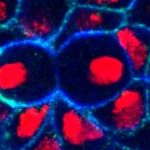Link to Pubmed [PMID] – 12361960
Development 2002 Oct;129(20):4677-84
An important issue in Metazoan development is to understand the mechanisms that lead to stereotyped patterns of programmed cell death. In particular, cells programmed to die may arise from asymmetric cell divisions. The mechanisms underlying such binary cell death decisions are unknown. We describe here a Drosophila sensory organ lineage that generates a single multidentritic neuron in the embryo. This lineage involves two asymmetric divisions. Following each division, one of the two daughter cells expresses the pro-apoptotic genes reaper and grim and subsequently dies. The protein Numb appears to be specifically inherited by the daughter cell that does not die. Numb is necessary and sufficient to prevent apoptosis in this lineage. Conversely, activated Notch is sufficient to trigger death in this lineage. These results show that binary cell death decision can be regulated by the unequal segregation of Numb at mitosis. Our study also indicates that regulation of programmed cell death modulates the final pattern of sensory organs in a segment-specific manner.

